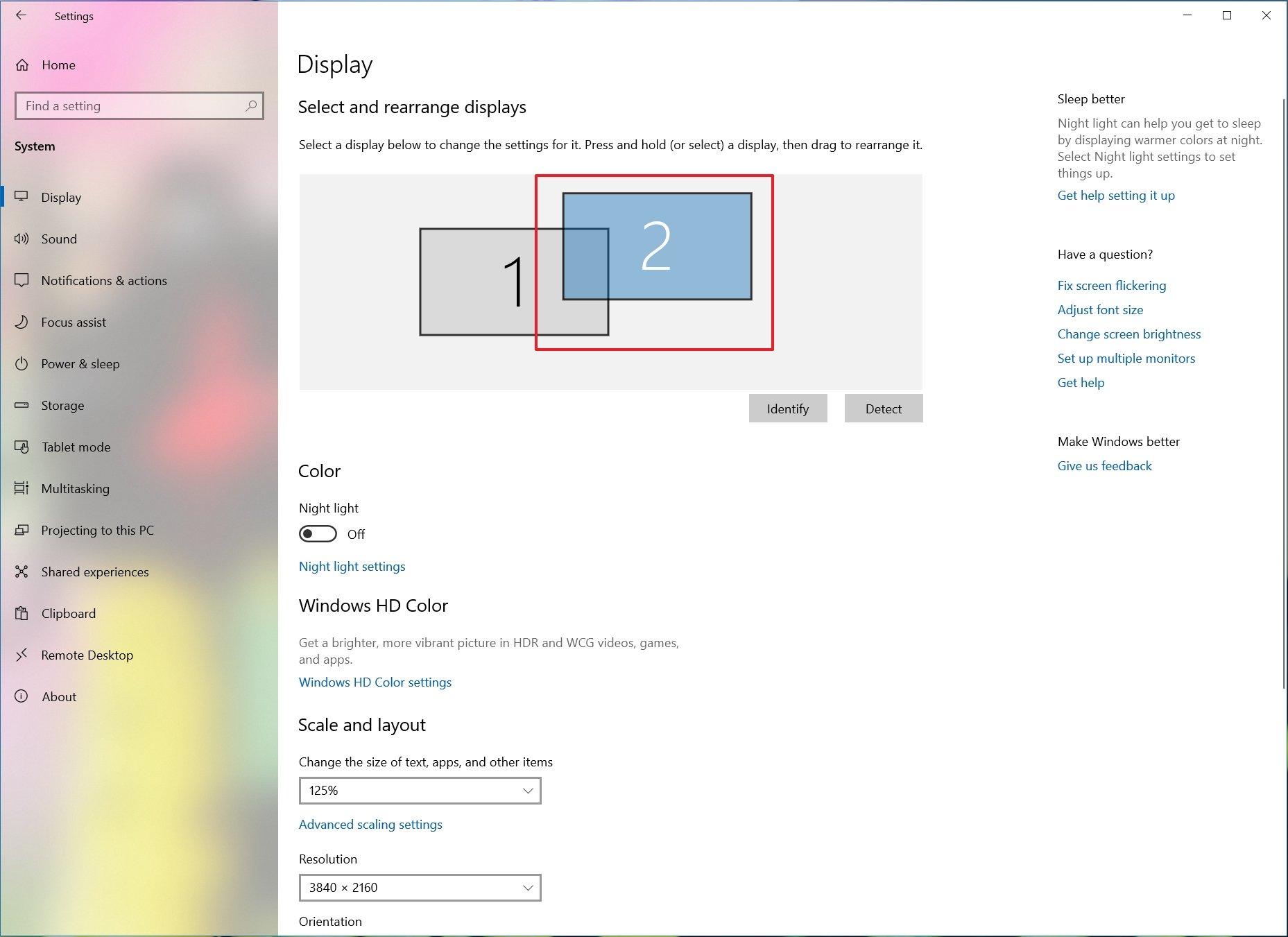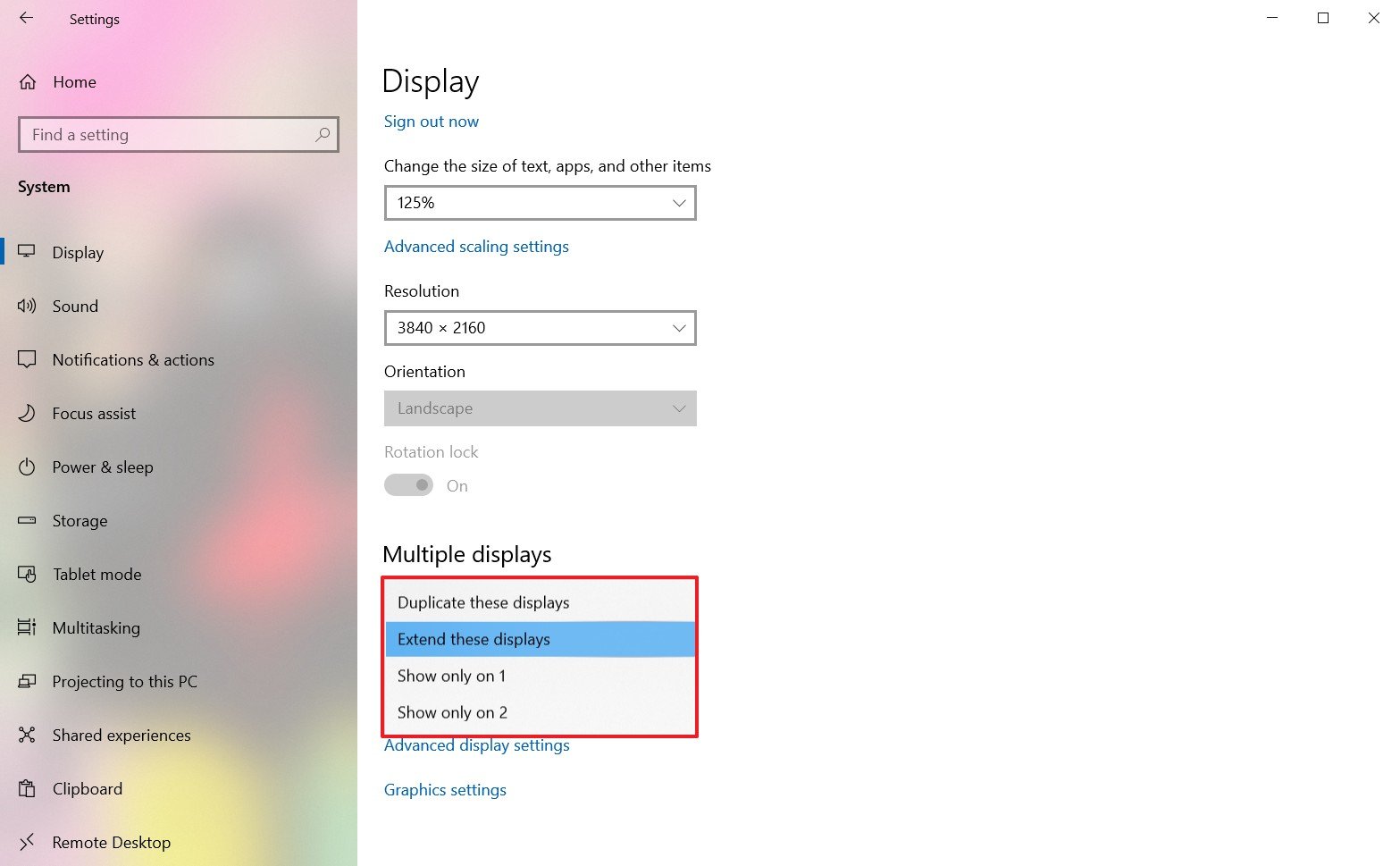How to Do Extended Screen on Windows 10
Whether you're content creator, programmer, data analyst, gamer, or someone who's recently been forced to work from home, a system with multiple monitors not only looks great, but it can significantly improve productivity when multitasking with several apps. However, a multi-monitor setup is only practical as long as you configure it correctly.
Windows 10 has several features and settings to support one, two, three, four, and even more monitors without the need for third-party software for the best experience.
In this Windows 10 guide, we'll walk you through a bunch of tips to configure and use a multi-monitor setup, whether you're connecting an external display to your laptop, or you're connecting two, three, or more monitors to your workstation.
- Before configuring a multi-monitor setup
- How to rearrange multiple displays on Windows 10
- How to adjust displays scale and layout on Windows 10
- How to select multiple displays viewing mode on Windows 10
- How to manage advanced display settings on Windows 10
- How to show taskbar across multiple displays on Windows 10
- How to change background on multiple displays on Windows 10
Before configuring a multi-monitor setup
Before configuring multiple monitors on your device, make sure that all the necessary cables are connected to the monitors and the computer. This includes connecting power and video signal using VGA, DVI, HDMI, or DisplayPort (recommended) cables.
If you're not sure, confirm the make and model of the monitor (usually from a sticker in the back), and search online for the manufacturer manual to get a better idea on how to connect the display.
How to rearrange multiple displays on Windows 10
While you can connect a monitor to any available video ports on the graphics card, when setting up a dual-monitor or triple-monitor setup, it's easy to plug them in the wrong order. Although they will still work, you may run into issues using the mouse and running applications until you rearrange them correctly.
To rearrange monitors on Windows 10, use these steps:
- Open Settings.
- Click on System.
- Click on Display.
-
Under the "Select and rearrange displays" section, drag and drop each display to rearrange them according to their physical layout on your desktop.
 Source: Windows Central
Source: Windows Central Quick tip: When rearranging monitors in the "Display" settings page, make sure that all monitors align at the top perfectly. Otherwise, you'll have problems moving the mouse cursor between monitors from the corners.
- Click the Apply button.
Once you complete the steps, Windows 10 will save the physical layout, and you'll be able to work across each display and run apps without issues.
If you're not sure which monitor you're selecting, click the Identify button to figure out. If one of the monitors isn't showing up, make sure it's receiving power and connected correctly, and click the Detect button. In the case that you're still having problems, reset their connections (or restart the computer), and try the Detect button again.
How to adjust displays scale and layout on Windows 10
When connecting one or multiple displays to a computer, Windows 10 does a pretty good job detecting and configuring the most optimal settings. However, depending on your requirements, you may need to adjust scaling, resolution, and orientation for each monitor.
Selecting correct scale
Windows 10 includes settings to adjust the scaling, which are useful when setting up various monitors of different sizes and screen resolutions to make text, apps, and other items look the same size across the displays. Or, if you have a 4K display, for example, adjusting the scale settings can help to make items bigger and more readable.
To select the correct scale setting that suits your requirements, use these steps:
- Open Settings.
- Click on System.
- Click on Display.
- Under the "Select and rearrange displays" section, select the monitor that you want to adjust.
-
Use the Change the size of text, apps, and other items drop-down menu to select the appropriate scale option.
 Source: Windows Central
Source: Windows Central
After you complete the steps, you may need to repeat steps No. 4 and 5 to change the scaling settings on the other monitors, and then click the Sign-out option to apply the changes.
While you can adjust the scaling settings on a per-monitor basis, when possible, it's always best to use the same make and model of the monitors with the same configuration. Otherwise, you may run into issues, and Windows 10 may have problems scaling elements.
If you're in the market for a second monitor to expand your laptop or desktop canvas, we recommend the Dell UltraSharp U2719D because of its accurate color reproduction, size, slim vessel design, VESA mount compatibility, and value.
Custom scaling
To specify a custom scaling value, use these steps:
- Open Settings.
- Click on System.
- Click on Display.
- Under the "Select and rearrange displays" section, select the monitor that you want to adjust.
-
Under the "Scale and layout" section, click the Advanced scaling settings option.
 Source: Windows Central
Source: Windows Central -
Under the "Custom scaling" section, specify the scaling size between 100 and 500 percent.
 Source: Windows Central
Source: Windows Central - Click the Apply button.
After you complete the steps, sign out of your account and sign back in to test the new settings. If the new scaling configuration doesn't look right, use the same steps again and try a different value until you find a comfortable setting.
If you want to switch to the predefined scale settings, you must first turn off custom scaling and sign out. Otherwise, the option will be grayed out.
Selecting correct resolution
Usually, after connecting a monitor, Windows 10 will set the recommended pixel resolution automatically, but you can also change the resolution manually with these steps:
- Open Settings.
- Click on System.
- Click on Display.
- Under the "Select and rearrange displays" section, select the monitor that you want to adjust.
-
Under the "Scale and layout" section, use the Resolution drop-down menu to select the correct pixel resolution.
 Source: Windows Central
Source: Windows Central
Once you complete the steps, repeat steps No. 4 and 5 to change the resolution on the remaining monitors.
If you're looking to make text and other items bigger on the screen, you should be changing the scaling settings, not the display resolution.
Selecting correct orientation
Windows 10 also allows you to rotate the screen horizontally or vertically, which is particularly useful when you have monitors with stands that rotate, and you want to use them with a different orientation for reading or coding.
To change the orientation per-monitor, use these steps:
- Open Settings.
- Click on System.
- Click on Display.
- Under the "Select and rearrange displays" section, select the monitor that you want to adjust.
-
Under the "Scale and layout" section, use the Orientation drop-down menu to select the mode:
- Landscape.
- Portrait.
- Landscape (flipped).
- Portrait (flipped).
 Source: Windows Central
Source: Windows Central
Once you complete the steps, the display will shift to the orientation you selected.
How to select multiple displays viewing mode on Windows 10
Using the available settings, you can also choose the viewing mode for your displays. For example, if you're using a second monitor, you can expand the main screen to the new display, or you can mirror both monitors, which is an ideal option when showing a presentation. If you're using a laptop with an external monitor, you can even disable the main display, and only use the second monitor as your primary.
To change the viewing mode on Windows 10, use these steps:
- Open Settings.
- Click on System.
- Click on Display.
- Under the "Select and rearrange displays" section, select the monitor that you want to adjust.
-
Under the "Multiple displays" section, use the drop-down menu to set the appropriate viewing mode:
- Duplicate desktop — Shows the same desktop on both displays.
- Extend — Expands the primary desktop to the secondary display.
- Disconnect this display — Turn off the selected monitor.
 Source: Windows Central
Source: Windows Central
After you complete the steps, you may need to repeat steps No. 4 and 5 to set the display mode on the remaining monitors. Also, note that using these settings, you can make any of the monitors as your primary display.
Switching display modes with shortcut
In addition to using the Settings app, Windows 10 also allows you to switch display modes on the fly using the Project feature, which you can access using the Windows key + P keyboard shortcut.
 Source: Windows Central
Source: Windows Central
Once you invoke the shortcut, a flyout will open from the right side with four options, including:
- PC screen only — Only the primary display is used.
- Duplicate — Secondary displays will mirror the primary monitor.
- Extend — Both screens are combined to offer an extended desktop.
- Second screen only — Only the secondary displays is used.
Typically, when using a multi-monitor setup on a desktop or laptop, you want to use the "Extend" option. This allows you to use the primary monitor normally and the secondary monitors at their native resolution creating a single large canvas.
Duplicate is a good option when using a second monitor or projector to show a presentation. In contrast, the Second screen only option is great when you want to close the lid on a laptop and work only with the external monitor.
How to manage advanced display settings on Windows 10
Although it's not always recommended to modify your advanced display settings, because not all monitors are created equal, sometimes, you may need to make a few adjustments to improve color accuracy and remove screen flickering.
Important: We only recommend adjusting the advanced settings if you have a rough idea of what to do. Typically, you should be fine with the default display settings.
Setting a custom color profile
If your monitors aren't rendering the colors accurately, you can use a custom color profile to improve color accuracy using these steps:
- Open Settings.
- Click on System.
- Click on Display.
-
Click the Advanced display settings option.
 Source: Windows Central
Source: Windows Central -
Click the Display adapter properties option for the display that you want to set a custom color profile.
 Source: Windows Central
Source: Windows Central - Click the Color Management tab.
-
Click the Color Management button.
 Source: Windows Central
Source: Windows Central - Click the Devices tab.
- Select a display from the list.
- Check the Use my settings for this display option.
-
Click the Add button.
 Source: Windows Central
Source: Windows Central -
On the "Associate Color Profile" page, click the Browse button and locate the new color profile.
 Source: Windows Central
Source: Windows Central - Double-click the .icm file to install the new profile.
-
Click the Close button.
 Source: Windows Central
Source: Windows Central
Once you complete the steps, you may need to repeat steps No. 9 through 13 to set a custom profile for the other monitors.
When configuring a custom color profile, you should use those created by your display manufacturer or from a trusted source. If you're not sure, you can use these steps to download the correct color profile for your monitors.
Changing the refresh rate
Usually, a refresh rate (frames per second) of 59Hz or 60Hz is more than enough to operate a computer, though you'll definitely want to look at the best monitors for Xbox Series X and Series S if you plan to game at higher framerates. However, if you're noticing screen flickering, or if you have monitors that support a higher refresh rate, bumping the settings can provide a better and smoother viewing experience — especially for gamers.
To adjust the refresh rate of a monitor, use these steps:
- Open Settings.
- Click on System.
- Click on Display.
-
Click the Advanced display settings option.
 Source: Windows Central
Source: Windows Central -
Click the Display adapter properties option for the display you want to change the refresh rate.
 Source: Windows Central
Source: Windows Central - Click the Monitor tab.
-
Under the "Monitor Settings" section, use the drop-down menu to set the correct refresh rate.
 Source: Windows Central
Source: Windows Central
After you complete the steps, you may need to repeat steps No. 5, 6, and 7 to change the refresh rate on the remaining monitors.
How to show taskbar across multiple displays on Windows 10
On a multi-monitor setup, the taskbar by default will appear only in the main display, but you can change the settings to show it across all the displays using these steps:
- Open Settings.
- Click on Personalization
- Click on Taskbar.
-
Under the "Multiple display" section, turn on the Show taskbar on all displays toggle switch.
 Source: Windows Central
Source: Windows Central
If you want to control in which taskbar the buttons for running apps should appear, then use the Show taskbar button on the drop-down menu and select one of the available options:
- All taskbars.
- Main taskbar and taskbar where window is open.
- Taskbar where window is open.
Also, you can use this guide to optimize the space on the taskbar to pin even more apps or to keep it as minimal as possible.
How to change background on multiple displays on Windows 10
Windows 10 offers a lot of settings to adjust the look and feel of the desktop, but when using multiple monitors, setting up different background images on each display is one the most significant customization that you can make to personalize your experience.
To show different wallpapers on a multi-monitor setup using a slideshow, use these steps:
- Open Settings.
- Click on Personalization.
- Click on Background.
-
Use the "Background" drop-down menu and select the Slideshow option.
 Source: Windows Central
Source: Windows Central - Click the Browse button.
- Select a folder with a collection of images that you'd like to display on the monitors.
- Click the Choose this folder button.
- Use the "Change picture every" drop-down menu to select the rotation frequency.
- Turn on the Shuffle toggle switch.
- (Optional) If you're using different sized images, use the Choose a fit drop-down menu and select the Fill option.
Once you complete the steps, the images will rotate on the desktop background using the rotation frequency that you selected.
Customizing each monitor with a different background
If you want to set a different background image for each monitor, use these steps:
- Open Settings.
- Click on Personalization.
- Click on Background.
-
Use the "Background" drop-down menu and select the Picture option.
 Source: Windows Central
Source: Windows Central - Click the Browse button.
- Select the wallpaper and click the Choose picture option.
-
Right-click the image and select the monitor you want the wallpaper to show.
 Source: Windows Central
Source: Windows Central - Repeat steps No. 5, 6, and 7 to set a custom background for another monitor.
After you complete the steps, each monitor will display a custom wallpaper.
In addition to the instructions outlined above, here are a few additional tips to keep in mind when setting up a computer with multiple monitors. For example, unless it's a laptop, you shouldn't try to adjust the brightness or color using Windows 10 or another application. Instead, you should use the controls built into the monitor.
In the case that the second monitor isn't getting detected, check its connections, and use the Detect button in the Settings app. If you're still having issues, you can use this guide to troubleshoot and fix common problems.
Finally, when using one or multiple monitors, you may come across a black screen, which it's typically a video driver related problem. If you're not sure how to fix this issue, you can follow these steps to resolve the problem.
More Windows 10 resources
For more helpful articles, coverage, and answers to common questions about Windows 10, visit the following resources:
- Windows 10 on Windows Central – All you need to know
- Windows 10 help, tips, and tricks
- Windows 10 forums on Windows Central
We may earn a commission for purchases using our links. Learn more.

Save on Xbox gear
Best Cyber Monday Xbox Series X deals 2021
Stock of the Xbox Series X will still be hard to find on Cyber Monday but there will be plenty of other items on offer. We're expecting big reductions on some top-of-the-line gaming headsets and if you've been looking to upgrade your storage there will be SSD and HDD offers galore. Controllers, Game Pass, and even TVs all feature too.
How to Do Extended Screen on Windows 10
Source: https://www.windowscentral.com/how-connect-and-set-multiple-monitors-windows-10

















